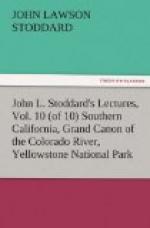[Illustration: FLAGSTAFF STATION.]
[Illustration: PACKING WOOD.]
[Illustration: A MEXICAN HOME.]
[Illustration: OUR CAR AT FLAGSTAFF.]
[Illustration: THE HEAVENS FROM THE OBSERVATORY, FLAGSTAFF.]
[Illustration: TWILIGHT.]
Upon a hill near Flagstaff stands an astronomical observatory from which distinguished students of the midnight skies search for the secrets of the moon and stars. Few better sites on earth could have been chosen for this purpose, since Arizona’s atmosphere is so transparent that the extent of celestial scenery here disclosed is extraordinary. We visited the structure at the solemn hour that marks the hush between two days, when the last sound of one has died away, and before the first stir of the other thrills the morning air. Then, gazing through the lenses of its noble telescope, we welcomed the swift waves of light pulsating toward us from the shoreless ocean we call space. There is a mysterious beauty about the radiance of a star that far surpasses that of the moon. The latter glitters only with reflected light; but a star (that is to say a distant sun), when seen through a telescope, frequently scintillates with different colors like a diamond, and quivers like a thing of life. Moreover, the moon, forever waxing, waning, or presenting almost stupidly its great flat face, is continually changing; but the fixed star is always there. It fills the thoughtful soul with awe to look upon the starry heavens through such an instrument as that at Flagstaff. Space for the moment seems annihilated. We are apparently transported, as observers, from our tiny planet to the confines of our solar system, and, gazing thence still farther toward infinity, we watch with bated breath the birth, the progress, and the death of worlds. To one of the most distant objects in the depths of space, known as the Ring Nebula, the author addressed the following lines:
TO THE RING NEBULA.
O, pallid spectre of the midnight skies!
Whose phantom features in
the dome of Night
Elude the keenest gaze of wistful eyes
Till amplest lenses aid the
failing sight,
On heaven’s blue sea the farthest
isle of fire.
From thee, whose glories it would fain
admire,
Must vision, baffled, in despair retire!
What art thou, ghostly visitant of flame?
Wouldst thou ’neath
closer scrutiny dissolve
In myriad suns that constellations frame,
Round which life-freighted
satellites revolve,
Like those unnumbered orbs which nightly
creep
In dim procession o’er the azure
steep,
As white-wing’d caravans the desert
sweep?
Or, art thou still an incandescent mass,
Acquiring form as hostile
forces urge,
Through whose vast length a million lightnings
pass
As to and fro its fiery billows
surge,
Whose glowing atoms, whirled in ceaseless
strife
Where now chaotic anarchy is rife.
Shall yet become the fair abodes of life?




